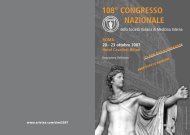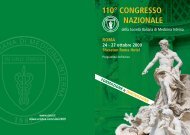HEARTLINE HSM Genoa Cardiology Meeting - Aristea
HEARTLINE HSM Genoa Cardiology Meeting - Aristea
HEARTLINE HSM Genoa Cardiology Meeting - Aristea
Create successful ePaper yourself
Turn your PDF publications into a flip-book with our unique Google optimized e-Paper software.
100<br />
(“gMPS"), che consiste di multipli sensori montati su aghi, li-guida, cateteri, permettendone<br />
la localizzazione sulla base della distanza dei sensori dalle numerose sorgenti di<br />
campi magnetici, con una accuratezza sub-millimetrica. La posizione -D e l’orientamento<br />
dei sensori possono essere proiettata gracamente su uno schermo ultrasonico, uoroscopico,<br />
TAC, RMN, sottraendo gli artefatti da battito cardiaco, respirazione o altri movimenti,<br />
e minimizzando l’uso di radiazioni ionizzanti. Attualmente la ricerca è limitata agli<br />
Stati Uniti d’America, pur disponendo già della certicazione CE.<br />
Al momento è possibile utilizzare un altro sistema (“ NAVEX SJM “ ) per la visualizzazione<br />
non uoroscopica, lungo il decorso dei vasi e nelle cavità cardiache, degli elettrocateteri per<br />
la stimolazione cardiaca. Da qualche mese, infatti, nel ns. Laboratorio si maturano esperienze<br />
con tale sistema di mappaggio elettro-anatomico, comunemente utilizzato per le<br />
ablazioni delle aritmie. Questa rappresenta un’interessante ed inesplorata applicazione,<br />
che permette di ridurre i tempi ed il carico di esposizione radiologica, sia per il paziente sia<br />
per gli operatori.<br />
• Pace-maker senza elettrodo/i:<br />
Due aziende hanno in avanzata fase di sperimentazione un Pace-maker miniaturizzato, più<br />
piccolo di un penny, impiantabile per via transcatetere, che si ssa direttamente sull’endocardio<br />
del ventricolo destro; tramite uno smartphone è possibile monitorare e controllare<br />
l’impianto a breve distanza. E’ prevista la disponibilità in clinica tra - anni; potrebbe<br />
eliminare i problemi connessi con gli elettrocateteri denitivi.<br />
Bibliograa<br />
1) Mond HG, Proclemer A. The 11 th World Survey of Cardiac Pacing and Implantable Cardioverter-Debrillators: Calendar Year 2009<br />
– A World Society of Arrhythmia’s Project. PACE 2011; : 101 -27<br />
2) Greenspon AJ, Patel JD, Lau, E, et al. 16-year trends in the infection burden for Pace-makers and Implantable Cardioverter-<br />
Debrillators in the United States. JACC 2011; 8: 1001-6<br />
) Wilkoff BL, et al. Transvenous Lead Extraction: HRS Expert Consensus on Facilities, Training, Indications, and Patient<br />
Management Transvenous. HRS Lead Extraction Consensus - 2009<br />
) Sweeney MO, Hellkamp AS, Ellembogen KA, et al. Adverse effect on ventticular pacing on heart failure and atrial brillation<br />
among patients with normal baseline QRS duration in a clinical trial of pace-maker therapy for sinus node dysfunction.<br />
Circulation 200 ; 107: 29 2-7<br />
) Yiu KH, Siu CW, Zhang XH et al. Left ventricular apical akinetic aneurysmatic area associated with permanent right ventricular<br />
apical pacing for advanced atrioventricular block: clinical characteristics and long-term outcome. Europace 2011; 1 : 1 -1<br />
6) Zhang XH, Chen H, Siu CW, Yiu KH et al. New-onset heart failure after permanent right ventricular apical pacing in patient with<br />
acquired high-grade atrioventrcular block and normal ventricular function. J Cardiovasc Electrophysiol 2008; 19: 1 6- 1<br />
7) Israel CW. Prevention of atrial brillation by prevention of ventricular pacing ? Europace 2011; 1 : 76 -7<br />
8) Funck RC, Boriani G, Manolis AS et al. The MINERVA study design and rationale: a controlled randomized trial to assess the<br />
clinical benet of minimizing ventricular pacing in pacemaker patients with atrial tachyarrhythmias. Am Heart J 2008; 1 6:<br />
- 1<br />
9) Santini L, Forleo G, Giudici V, et al. Right ventricular lead placement in PM recipients: current trends toward alternative sites.<br />
Preliminary data from the Opti-Mind study population. Venice Arrhythmias 2011<br />
10)Tops L, Schalij M, Bax J. Effect of right ventricular apical pacing and cardiac resynchronization therapy on left ventricular<br />
dyssynchrony and function. Pag 97, Chapter 9 in Cardiac resynchronization therapy in heart failure. Abraham W, Ragavendra<br />
B., Lippincott, Williams & Wilkins, 2010.<br />
11)El-Cham W, Leon A. Safety of cardiac resynchronization therapy. Pag.92-96, Chapter 8 in Cardiac resynchronization therapy<br />
in heart failure. Abraham W, Ragavendra B., Lippincott, Williams & Wilkins, 2010.<br />
12)Leon A, Abraham WT, Curtis AB, et al. Safety of transvenous cardiac resynchronization system implantation in patients with<br />
chronic heart failure: combined results of over 2,000 patients from a multicenter study program. JACC 200 ; 6: 2 8- 6.





